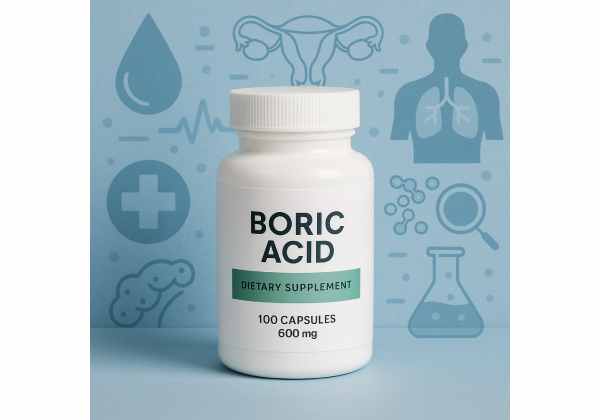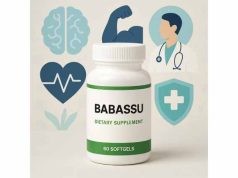
Boric acid, a versatile compound naturally derived from boron, is gaining increased attention for its diverse health, hygiene, and household uses. While well-known as a cleaning and pest control agent, boric acid also plays a unique role in personal wellness—especially for vaginal health, recurrent infections, and topical relief of fungal issues. It’s recognized for its potent antifungal, antiviral, and antiseptic properties, making it a go-to natural remedy for many persistent conditions when used appropriately. However, safety and correct usage are crucial, as boric acid can be toxic if misused. This comprehensive guide reveals how boric acid works, its research-backed benefits, ideal dosage and forms, and essential precautions for anyone considering it as a supplement or home remedy.
Key Takeaways
- Antifungal and Antimicrobial Power: Boric acid is effective for yeast infections and bacterial imbalances, particularly in women’s health.
- Versatile Uses: From personal hygiene (vaginal suppositories) to external skin applications and home cleaning.
- Strict Dosage and Safety Required: Always follow medical guidance—boric acid is toxic if ingested in high doses.
- Not for Everyone: Unsuitable for children, pregnancy, or oral supplementation; topical and intravaginal use only under supervision.
- Evidence-Backed, Not a Cure-All: Useful for persistent infections when other treatments fail, but not a substitute for medical diagnosis.
Table of Contents
- Boric Acid Overview: History, Chemistry, and Core Uses
- How Boric Acid Works: Antifungal and Biological Mechanisms
- Evidence-Based Benefits and Proven Applications of Boric Acid
- Boric Acid Safety Profile, Potential Side Effects, and Interactions
- Boric Acid Dosage Guidelines, Forms, and Best Practices for Use
- Boric Acid FAQ: Answers to Top User Questions
Boric Acid Overview: History, Chemistry, and Core Uses
Boric acid, chemically known as hydrogen borate (H₃BO₃), is a naturally occurring compound found in seawater, volcanic areas, and certain minerals. Its discovery and use date back centuries, with applications ranging from medicine and preservation to pest control and household cleaning.
Origins and Physical Properties
- Natural Sources: Boric acid is found in mineral deposits and produced by the chemical reaction of borax (another boron compound) with acids.
- Appearance: It is a white, odorless, crystalline powder, easily soluble in water and slightly acidic.
- Stability: Chemically stable, boric acid maintains its properties across a wide temperature range, contributing to its widespread use.
Historical and Modern Uses
- Medicinal: Used since the 1800s as an antiseptic for wounds, eye washes, and feminine hygiene solutions.
- Household: A well-known ingredient in laundry detergents, antiseptic sprays, mold removers, and pest control powders.
- Industrial: Important in glassmaking, ceramics, flame retardants, and photographic chemicals.
Medical and Personal Care Applications
- Vaginal Health: Most notable today for treating recurrent yeast infections (vaginal candidiasis) and bacterial vaginosis when standard treatments fail.
- Dermatology: Used topically for athlete’s foot, minor burns, cuts, and as a foot soak for odor or fungal issues.
- Ophthalmology: Dilute solutions serve as gentle eyewashes for minor irritations (though this use is less common today due to safety advances).
Why is Boric Acid Still Used in Medicine and Hygiene?
- Broad Antimicrobial Spectrum: Effective against fungi (especially Candida), bacteria, and some viruses.
- Non-Antibiotic Mechanism: Unlike antibiotics or antifungals, boric acid works by disrupting the environment that pathogens need to thrive, making resistance less likely.
- Low Cost and Accessibility: Over-the-counter boric acid suppositories are available for self-care, but should only be used with professional guidance.
Forms and Delivery Methods
- Vaginal Suppositories: Most common for personal use—gelatin capsules filled with pure boric acid powder.
- Powders and Solutions: For external application on the skin, as soaks, or household use.
- Medical Preparations: Creams, ointments, and sterile solutions, sometimes compounded by pharmacists.
Who Should Use Boric Acid?
- Women with recurrent vaginal infections unresponsive to conventional treatments.
- Adults with persistent athlete’s foot or fungal skin problems.
- Those seeking a natural antimicrobial for home hygiene (with appropriate handling).
Boric acid’s long history, coupled with modern research, makes it a unique and valuable compound for targeted, evidence-based use—always with a strong emphasis on safety.
How Boric Acid Works: Antifungal and Biological Mechanisms
The effectiveness of boric acid lies in its distinctive mode of action against a wide array of microbes and its unique impact on body environments where infections often persist. Here’s a look at the science behind its benefits and limitations.
1. Antifungal Action and Vaginal Health
- Disrupts Fungal Growth: Boric acid interferes with the cell walls and metabolic pathways of Candida species, effectively limiting their ability to multiply and survive.
- Restores Vaginal pH: Many vaginal infections thrive in an imbalanced (less acidic) environment. Boric acid re-acidifies the vaginal canal, creating conditions that discourage fungal and bacterial overgrowth.
- Resistant Infections: Especially useful for non-albicans species of yeast or chronic cases that fail to respond to standard antifungal medications.
2. Antibacterial and Antiviral Effects
- Cell Wall Disruption: Boric acid damages the outer membranes of bacteria, rendering them less able to reproduce and cause infection.
- Biofilm Prevention: It can help break down biofilms—protective layers formed by bacteria and fungi—which are often responsible for recurrent or chronic infections.
- Mild Antiviral Properties: Although not a cure, boric acid’s pH-modifying effect can discourage some viruses from establishing infections on skin or mucous membranes.
3. Topical Antiseptic and Astringent Qualities
- Skin Protection: When used in dilute solutions, boric acid soothes irritated skin, dries out weeping wounds, and prevents secondary infections.
- Odor Control: Its antimicrobial action can help reduce odor-causing bacteria in feet and underarms.
4. Environmental and Household Impact
- Pest Control: Boric acid is toxic to insects (especially cockroaches and ants) by damaging their digestive system and exoskeleton.
- Mold and Bacteria: Used as a non-bleach cleaner to kill mold and bacterial colonies in damp environments.
How Is Boric Acid Different from Other Antifungals and Antiseptics?
- Not Absorbed Well by the Body: Most of its effects are localized, which is why it’s generally safe for topical and vaginal use but not for oral consumption.
- Low Resistance Risk: Because it disrupts environments, rather than targeting single pathways, microbes are less likely to develop resistance.
Limitations of Boric Acid’s Mechanism
- Toxic if Swallowed: Boric acid should never be taken orally; ingestion can cause serious poisoning.
- Not for Systemic Infections: Only effective where it can be applied directly.
Who Benefits Most?
- Individuals with recurrent, treatment-resistant fungal or bacterial infections in the vagina or skin.
- People seeking non-antibiotic alternatives for hygiene and household uses.
Understanding how boric acid works helps users maximize its benefits while avoiding unnecessary risks.
Evidence-Based Benefits and Proven Applications of Boric Acid
Boric acid’s resurgence in natural medicine and self-care is backed by substantial evidence for specific, targeted uses—most notably for vaginal infections, skin problems, and external hygiene. Here’s what the science and clinical experience say about its most valuable roles.
1. Treating Recurrent Vaginal Yeast Infections
- High Success Rate: Boric acid vaginal suppositories resolve up to 70–90% of chronic and treatment-resistant yeast infections, particularly those caused by non-albicans strains.
- Symptom Relief: Provides rapid reduction in itching, burning, abnormal discharge, and odor—often within a few days.
- Maintenance Use: Some protocols recommend periodic use (e.g., twice weekly) for women with frequent recurrences, always under medical supervision.
2. Managing Bacterial Vaginosis (BV)
- Restores Vaginal Flora: Boric acid helps re-balance bacteria in the vagina, reducing the symptoms of BV and preventing relapse.
- Alternative to Antibiotics: For women who don’t respond to standard medications, boric acid offers a valuable non-antibiotic alternative.
3. Topical Relief for Athlete’s Foot and Skin Infections
- Antifungal Foot Soaks: Boric acid powders or solutions help dry, disinfect, and soothe feet affected by athlete’s foot, ringworm, or fungal nail infections.
- Wound Care: Historically used for minor cuts and burns (though less common now due to safer modern antiseptics).
4. Hygiene and Odor Control
- Foot and Shoe Powders: Keeps feet dry, discourages fungal growth, and controls odor when dusted in shoes or socks.
- Antiseptic Cleansers: Mild solutions clean surfaces, laundry, and personal care items (with proper handling and rinsing).
5. Cost-Effective, Accessible Solution
- OTC Access: Available over the counter in many countries, boric acid products offer an affordable alternative for persistent health and household concerns.
- Less Resistance Risk: Because it targets multiple types of microbes and disrupts their environment, resistance is rare.
Limitations and Important Considerations
- Not a Cure-All: Boric acid is highly effective for specific conditions but not intended for general or preventive use.
- Medical Supervision Needed: Always necessary for prolonged or repeated vaginal use, especially if you are pregnant, trying to conceive, or have health conditions.
Who Should Consider Boric Acid?
- Women with recurrent vaginal infections that don’t respond to standard therapies.
- Adults with stubborn athlete’s foot or fungal skin infections.
- Those seeking a natural, cost-effective antimicrobial for targeted household or hygiene applications.
Boric acid’s value lies in its precision: when used for the right problems, it delivers impressive results.
Boric Acid Safety Profile, Potential Side Effects, and Interactions
While boric acid offers powerful relief for persistent infections and hygiene concerns, its safety profile is nuanced and requires careful adherence to guidelines. This section outlines the tolerability, risks, and potential interactions for users, with an emphasis on responsible, well-informed use.
General Safety Considerations
- Topical and Intravaginal Use Only: Boric acid is safe for adults when used externally or as prescribed vaginal suppositories. It is not intended for oral ingestion or use in open wounds.
- Never for Oral Consumption: Swallowing boric acid is toxic and potentially fatal. Accidental ingestion requires immediate medical attention.
- Children and Pets: Boric acid should be kept well out of reach of children and pets, as even small amounts can be dangerous.
Potential Side Effects
- Local Irritation: Mild burning, watery discharge, or redness may occur in some women using vaginal suppositories. These symptoms are generally temporary and improve with continued use or after stopping.
- Skin Sensitivity: When applied to broken or sensitive skin, boric acid may cause stinging or increased irritation. Dilute solutions are best for external skin issues.
- Rare Allergic Reactions: Hives, swelling, or difficulty breathing are rare but require discontinuation and prompt medical evaluation.
Toxicity and Overuse Risks
- Acute Poisoning Symptoms: Nausea, vomiting, diarrhea, abdominal pain, blue-green vomit, skin rash, confusion, or even seizures can occur after ingestion or excessive topical use. These are medical emergencies.
- Chronic Exposure: Prolonged or repeated high-dose use, especially over large skin areas or mucous membranes, can cause kidney or nervous system damage.
Special Precautions: Who Should Avoid Boric Acid?
- Pregnancy and Trying to Conceive: Boric acid is not recommended for use during pregnancy or by those attempting conception due to potential harm to the fetus.
- Children and Infants: Never use boric acid for diaper rash, ear infections, or any pediatric application.
- Severe Skin Conditions or Open Wounds: Avoid using boric acid on large wounds or broken skin to prevent systemic absorption.
- Known Allergy to Boron Compounds: Discontinue use if allergic symptoms appear.
Potential Drug and Supplement Interactions
- Limited Drug Interactions: Boric acid is primarily used topically or intravaginally, so systemic drug interactions are rare. However, always disclose its use to your healthcare provider.
- Combination with Other Irritants: Avoid using alongside other harsh topical agents (e.g., hydrogen peroxide, strong acids, alcohol-based cleansers) to prevent compounded irritation.
Best Practices for Safe Use
- Follow Professional Instructions: Only use boric acid as directed by your healthcare provider or on product labels.
- Limit Duration: For vaginal use, most protocols recommend 7–14 days per treatment cycle, or as prescribed. Do not use daily or indefinitely.
- Use Appropriate Form: Only pharmaceutical-grade boric acid from a trusted pharmacy or manufacturer should be used for health purposes.
- Storage and Handling: Store in a secure, dry place away from children and food items.
- Rinse Well After Skin Use: For soaks or washes, thoroughly rinse the area to prevent skin buildup or accidental ingestion.
What to Do in Case of Adverse Effects or Accidental Ingestion
- Mild Discomfort: Stop use and monitor for improvement. Most mild local reactions resolve quickly.
- Serious Reactions: If you experience severe irritation, allergic symptoms, or signs of poisoning, seek emergency medical help immediately.
Summary of Key Safety Points
- Only for adult topical or vaginal use—never ingest.
- Not for children, pregnancy, or use on large or broken skin areas.
- Discontinue and consult a doctor if significant side effects or allergic reactions occur.
- Safe and effective when used responsibly for the right conditions.
Adhering to these guidelines ensures boric acid’s powerful benefits can be realized without unnecessary risks.
Boric Acid Dosage Guidelines, Forms, and Best Practices for Use
Proper dosing and responsible use are critical when utilizing boric acid for personal health or hygiene. Unlike many supplements, boric acid’s effectiveness and safety are closely linked to strict adherence to established guidelines. This section offers practical advice for both new and experienced users.
Vaginal Use: Dosage and Protocols
- Standard Suppository Dosage: The most common and evidence-based regimen is one 600 mg boric acid suppository inserted vaginally once daily for 7–14 days to treat active yeast infections or bacterial vaginosis.
- Maintenance Protocol: For women with recurrent infections, some healthcare providers recommend 1 suppository two to three times per week for up to six months. Always follow a doctor’s instructions.
- Insertion Tips: Wash hands thoroughly before and after use. Lie down during insertion to prevent leakage. Use at bedtime for comfort.
Topical Application: Skin and Foot Use
- Powders and Soaks: For athlete’s foot or skin fungus, use a solution of 2–5% boric acid in water as a soak for 15–30 minutes daily, or dust affected areas lightly with boric acid powder.
- Spot Treatments: Apply only to intact skin. Do not use on large areas or open wounds.
Forms of Boric Acid for Health Use
- Pharmaceutical-Grade Suppositories: Available over the counter or by prescription; pre-filled capsules are safest and most consistent.
- Pure Powder: Can be placed into gelatin capsules if pharmacy products are unavailable, but strict care is needed to measure the dose precisely.
- Topical Solutions: Pharmacies or specialty suppliers offer ready-to-use solutions or creams for external use.
Timing and Duration of Use
- Vaginal Health: Use for the full recommended duration, even if symptoms resolve early. Do not exceed recommended cycles without a doctor’s guidance.
- Skin and Hygiene: For athlete’s foot or other skin concerns, use until symptoms are gone plus a few extra days, then discontinue.
How to Choose Quality Boric Acid Products
- Look for Pharmaceutical-Grade: Only use boric acid labeled for medical or personal care use—not technical or industrial grades.
- Third-Party Testing: Reputable brands offer products tested for purity and absence of contaminants.
- Avoid Homemade Solutions for Vaginal Use: Self-prepared solutions or capsules may not be sterile, risking infection.
Special Populations: Dosage Adjustments and Cautions
- Pregnancy and Lactation: Do not use boric acid during pregnancy or breastfeeding.
- Chronic Health Issues: Consult your doctor before use if you have immune suppression, diabetes, or kidney disease.
When to Seek Medical Help
- No Improvement: If symptoms persist after a full course, consult a healthcare professional.
- Worsening Symptoms: Stop use and seek help for increased pain, burning, or signs of allergic reaction.
- Accidental Ingestion: Treat as a medical emergency and contact poison control immediately.
Summary of Usage Best Practices
- Follow evidence-based protocols: 600 mg vaginally for 7–14 days is most common for infections.
- Only use pharmaceutical-grade products; avoid industrial boric acid.
- Do not exceed recommended duration or frequency.
- Consult a professional for persistent or complicated cases.
By following these guidelines, users can achieve optimal results from boric acid while minimizing risks.
Boric Acid FAQ: Answers to Top User Questions
What is boric acid used for in women’s health?
Boric acid is most commonly used as a vaginal suppository to treat recurrent yeast infections and bacterial vaginosis, especially when standard treatments fail or resistance is present.
Is boric acid safe for regular vaginal use?
Yes, boric acid is safe for short-term vaginal use in most healthy, non-pregnant adults when used as directed. Always avoid oral ingestion and follow medical advice for duration and frequency.
Can you swallow or ingest boric acid for health benefits?
No, boric acid should never be ingested. Oral consumption is toxic and can cause severe, even fatal, poisoning.
What are the side effects of boric acid suppositories?
Some users may experience mild burning, watery discharge, or local irritation. Severe symptoms are rare but require discontinuation and medical evaluation.
Is boric acid safe in pregnancy or breastfeeding?
No, boric acid should not be used during pregnancy or breastfeeding due to the risk of harm to the fetus or infant.
Can boric acid be used for athlete’s foot or fungal skin infections?
Yes, boric acid solutions or powders can help treat athlete’s foot and certain skin infections when used externally and as directed.
How quickly does boric acid work for yeast infections?
Most women experience significant symptom relief within a few days of starting boric acid suppositories, with full results in 7–14 days.
Disclaimer:
This article is for educational and informational purposes only. It is not a substitute for professional medical advice, diagnosis, or treatment. Always consult your healthcare provider before starting any new supplement or remedy, especially with sensitive products like boric acid.
If this boric acid guide helped you, please share it on Facebook, X (formerly Twitter), or your favorite social platform—and follow us for more trusted health content. Your support helps us continue producing in-depth wellness resources for you and your community. Thank you!










